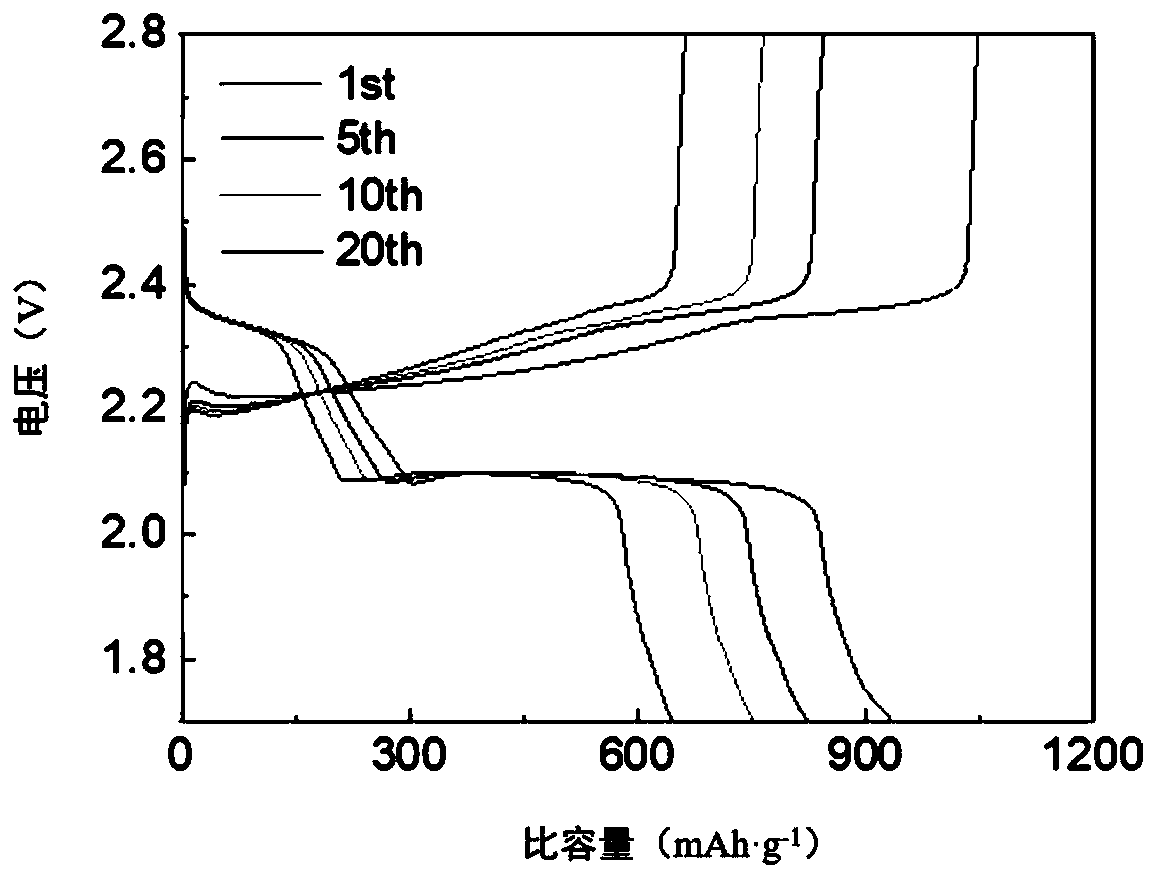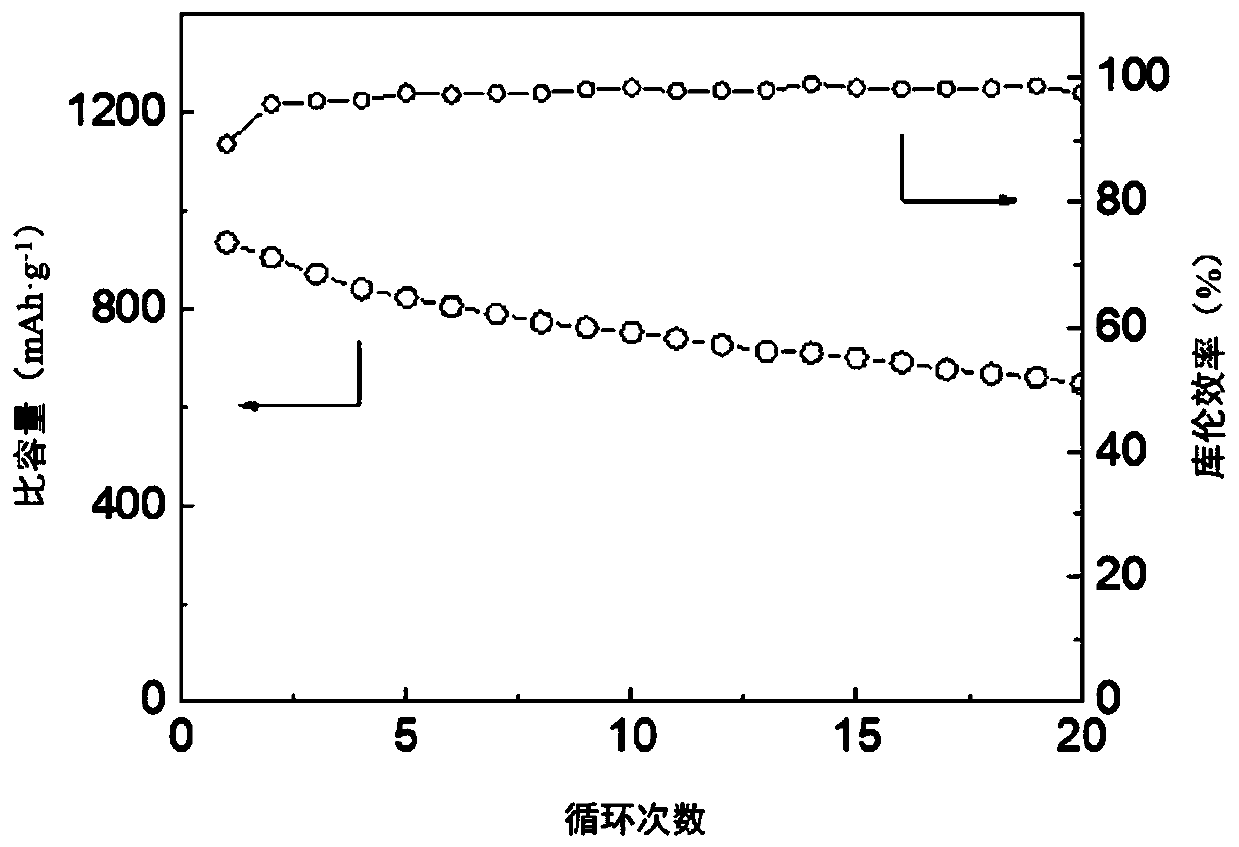Preparation method and application of single crystal mesoporous Mo3N2 for positive electrode material of lithium-sulfur battery
A technology for lithium-sulfur batteries and cathode materials, applied in nanotechnology for materials and surface science, battery electrodes, lithium batteries, etc., can solve problems such as high conductivity and reduce electrode kinetics, and achieve increased sulfur loading, Effects of overcoming low utilization rates, high yields and industrial viability
- Summary
- Abstract
- Description
- Claims
- Application Information
AI Technical Summary
Problems solved by technology
Method used
Image
Examples
Embodiment 1
[0025] The first step: preparation of single crystal molybdenum oxide nanowires;
[0026] Ammonium molybdate tetrahydrate ((NH 4 ) 6 Mo 7 o 24 4H 2 O, (99%, Sigma Aldrich) dissolved in 5M HNO 3 (70%, Sigma Aldrich), stirring was continued at 20°C for half an hour, then at 150°C for 2 hours. After the hydrothermal process, the generated precipitate is cooled to room temperature, washed with ethanol and distilled water, and then filtered with a filter device. Molybdenum oxide nanowires were obtained by drying in an oven at 50°C.
[0027] The second step: preparation of single crystal mesoporous molybdenum nitride nanowires,
[0028] The single crystal molybdenum oxide nanowires prepared in the first step were loaded into a quartz boat, which was placed in a glass quartz tube in a cylindrical furnace, heated at 600 °C for half an hour, and then heated in NH at a flow rate of 100 mL / min. 3 Hold for 2 hours. sample in flowing NH 3 Cooled to room temperature, passivated in...
Embodiment 2
[0030] The first step: preparation of single crystal molybdenum oxide nanowires;
[0031] Ammonium molybdate tetrahydrate ((NH 4 ) 6 Mo 7o 24 4H 2 O, (99%, Sigma Aldrich) dissolved in 5M HNO 3 (70%, Sigma Aldrich), stirring was continued at 25°C for 1 hour, then at 160°C for 3 hours. After the hydrothermal process, the generated precipitate is cooled to room temperature, washed with ethanol and distilled water, and then filtered with a filter device. Molybdenum oxide nanowires were obtained by drying in an oven at 50°C.
[0032] The second step: preparation of single crystal mesoporous molybdenum nitride nanowires,
[0033] Load the single-crystal molybdenum oxide nanowires prepared in the first step into a quartz boat, which is placed in a glass-quartz tube in a cylindrical furnace, heated at 700 °C for 1 hour, and then heated in NH at a flow rate of 100 mL / min. 3 Hold for 3 hours. sample in flowing NH 3 Cooled to room temperature, passivated in ammonia containing 1...
Embodiment 3
[0037] The first step: preparation of single crystal molybdenum oxide nanowires;
[0038] Ammonium molybdate tetrahydrate ((NH 4 )6Mo 7 o 24 4H 2 O, (99%, Sigma Aldrich) dissolved in 5M HNO 3 (70%, Sigma Aldrich), stirring was continued at 30°C for 1.5 hours, then at 170°C for 4 hours. After the hydrothermal process, the generated precipitate is cooled to room temperature, washed with ethanol and distilled water, and then filtered with a filter device. Molybdenum oxide nanowires were obtained by drying in an oven at 50°C.
[0039] The second step: preparation of single crystal mesoporous molybdenum nitride nanowires,
[0040] The single-crystal molybdenum oxide nanowires prepared in the first step were loaded into a quartz boat, which was placed in a glass-quartz tube in a cylindrical furnace, heated at 800 °C for 1.5 h, and then heated in NH at a flow rate of 100 mL / min. 3 Hold for 4 hours. sample in flowing NH 3 Cooled to room temperature, passivated in ammonia cont...
PUM
| Property | Measurement | Unit |
|---|---|---|
| current efficiency | aaaaa | aaaaa |
Abstract
Description
Claims
Application Information
 Login to View More
Login to View More - R&D
- Intellectual Property
- Life Sciences
- Materials
- Tech Scout
- Unparalleled Data Quality
- Higher Quality Content
- 60% Fewer Hallucinations
Browse by: Latest US Patents, China's latest patents, Technical Efficacy Thesaurus, Application Domain, Technology Topic, Popular Technical Reports.
© 2025 PatSnap. All rights reserved.Legal|Privacy policy|Modern Slavery Act Transparency Statement|Sitemap|About US| Contact US: help@patsnap.com


